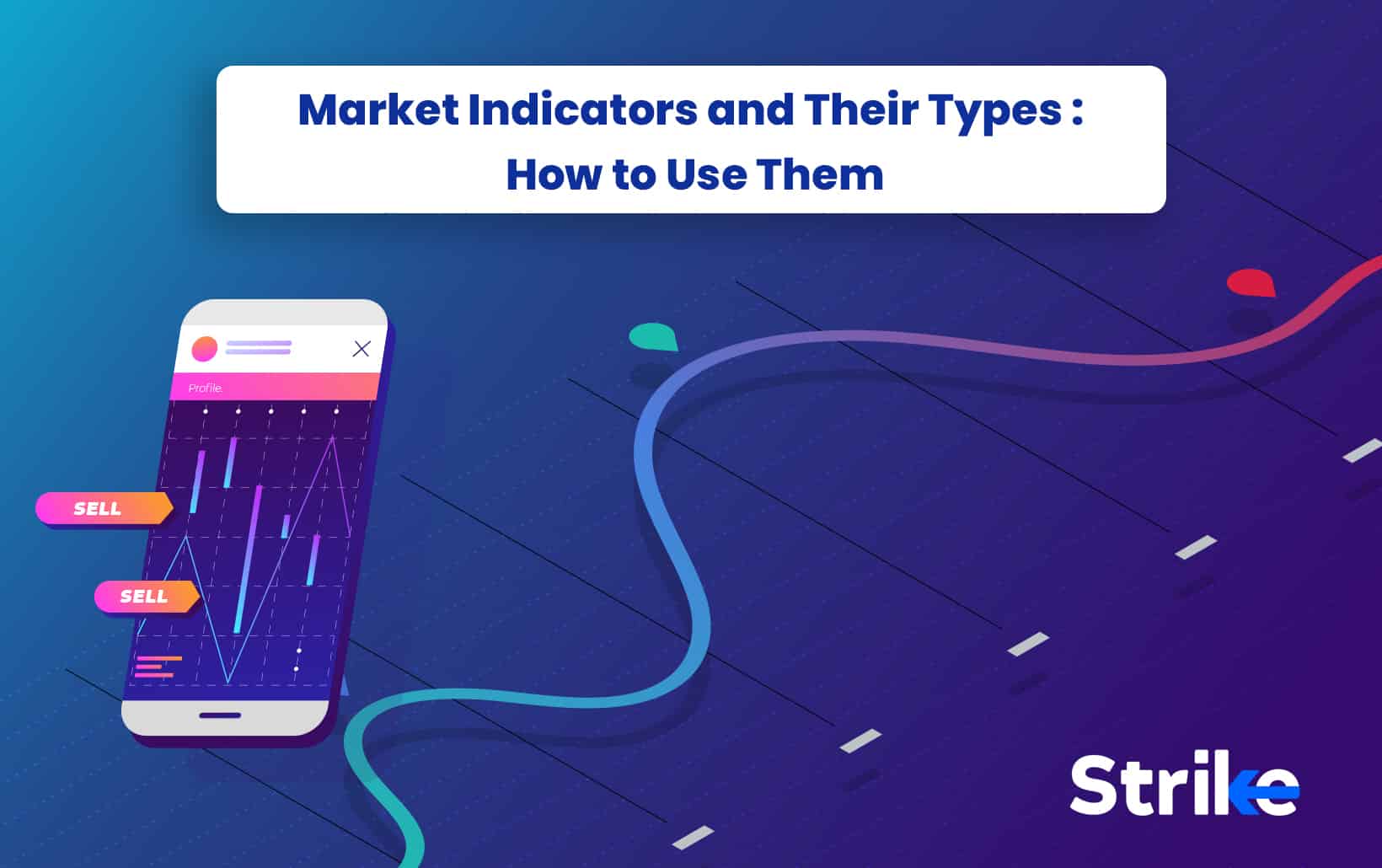
Market indicators act as quantitative measures for traders to forecast market trends and variations by using financial ratios and other necessary collected information. Market indicators give the analyst’s perspective on the market and serve as a justification for their market expectations.
Stock market indicators are quantitative tools used by investors to understand financial data. The goal is to predict stock market movements and benefit from them. Stock market indicators include details such as the upper/lower ratio, advance/decline ratio, delivery ratio, and the 52-week high/low ratio etc.
Market breadth, market volume, moving averages, and on-balance volume are important types of market indicators.
Market indicators use information gathered from various securities traded on a specific market or from a portion of an index. Market indicators are derived by using statistical formulas to a set of data points to obtain actionable inputs. Market indicators, unlike technical indicators, do not focus much on chart patterns.
What are Market Indicators?
Market indicators are quantitative indicators that aim to predict market movements by interpreting financial index or stock market data. The market indicator is a category of technical indicators that are composed of formulas and ratios. Market indicators apply a statistical formula to a set of data points, they collect their data from numerous securities. Market indicators frequently show on their chart rather than above or below an index price chart.
How do Market Indicators Work?
The market indicator displays a visual depiction of the price inputs and mathematical formula. An indicator won’t reveal anything more to a novice trader or chart reader than what is already obvious when studying the price chart (or volume chart) alone without any additional indicators. You can see the movement of prices using indicators. For example, You choose the market you want to trade on after logging into your favorite trading site. Most systems offer a variety of indicators and enable you to select the type of chart you like. An array of indicators are available for traders. People avoid using more than 2 indicators together because it looks crowded.
What are the types of Market Indicators?
There are 4 main types of market indicators; market sentiment, moving averages, market breadth, and advance decline.
1. Market Sentiment:
Market sentiment explains how investors feel about the financial market or specific security. It is the general vibe or tone of a market or crowd psychology depicted in the activity or price variation of securities traded in that market. Rising prices suggest a bullish market sentiment whereas declining prices indicate a bearish market sentiment. Market sentiment, sometimes referred to as “investor sentiment,” is not completely determined by fundamentals. Market sentiment is crucial for analysts and day traders since it affects the technical indicators they apply to keep track of the short-term price fluctuations that are often influenced by the trader’s attitude towards a security. It is also essential for investors who prefer to trade against the trend of the existing consensus. In this case, such an investor would sell while everyone else is buying.
2. Moving Averages:
A moving average is a market indicator often used in technical analysis in finance. The purpose of generating a stock’s moving average is to create a continuously updated average price in order to smooth out the price data. The effects of random, short-term changes on the price of a stock over a given time are reduced by using the moving average calculation. Simple moving averages (SMAs) apply a basic arithmetic average of prices over a time period, however, exponential moving averages (EMAs) give more weight to more recent values than to older ones over the same time period. Moving averages are calculated to recognize the trend direction of a stock or its support and resistance levels. It is generally defined as a trend-following or lagging indicator since it is based on past prices.
3. Market Breadth:
Market breadth indicators examine the information from many stocks with comparable price movements. It allows traders to predict the direction of the trend in the upcoming days. The number of firms that set new highs and the number of stocks that reach new lows are compared within a given timeframe. The market breadth is useful for trend traders who make money by basically investing in market trends in terms of price variations. Trends are regarded as primarily no-risk if the indicators used are reliable, and the risk involved is appropriately accounted for.
4. Advance-decline:
Advances and declines are usually the proportion of securities that concluded at a higher price against a lower price from the previous trading day. Advances and declines are the foundation of many different market indicators like the advance-decline index, absolute breadth index, and the advance-decline ratio. An oversold market is indicated by a low advance-decline ratio, whilst an overbought market is indicated by a high advance-decline ratio. Either of these circumstances can indicate that a market trend is no longer viable and is going to change direction.
What are the Most Popular Market Indicators?
The 24 most popular market indicators are Moving Average Convergence and Divergence (MACD), Commodity Channel Index, Relative strength index(RSI), Stochastic Indicator, Super Trend, William %R, Volume, Price Volume Trend, Exponential Moving Average (EMA), Open Interest, McClellan Oscillator, Fibonacci Retracement, On Balance Volume Indicator, Aroon, Correlation Coefficient, Money Flow Index, Bollinger Bands, Donchain, Volume-Weighted Average Price(VWAP), New Highs-New Lows, McClellan Ratio-Adjusted Oscillator, Average Directional Index, Ticks Index, and Plurality Index.
Moving Averages
Moving averages are a commonly used indicator in technical analysis. They are calculated to mitigate the small term fluctuations in the market. Calculating the moving average would give the trader an idea about the average value of the stock prices. Moving averages can also be used by the traders to calculate the support and resistance levels as well.
Moving Average Convergence and Divergence (MACD)
The Moving Average Convergence Divergence (MACD) indicator measures the difference between two time periods that make up a collection of historical time series in order to understand momentum and its directional strength.
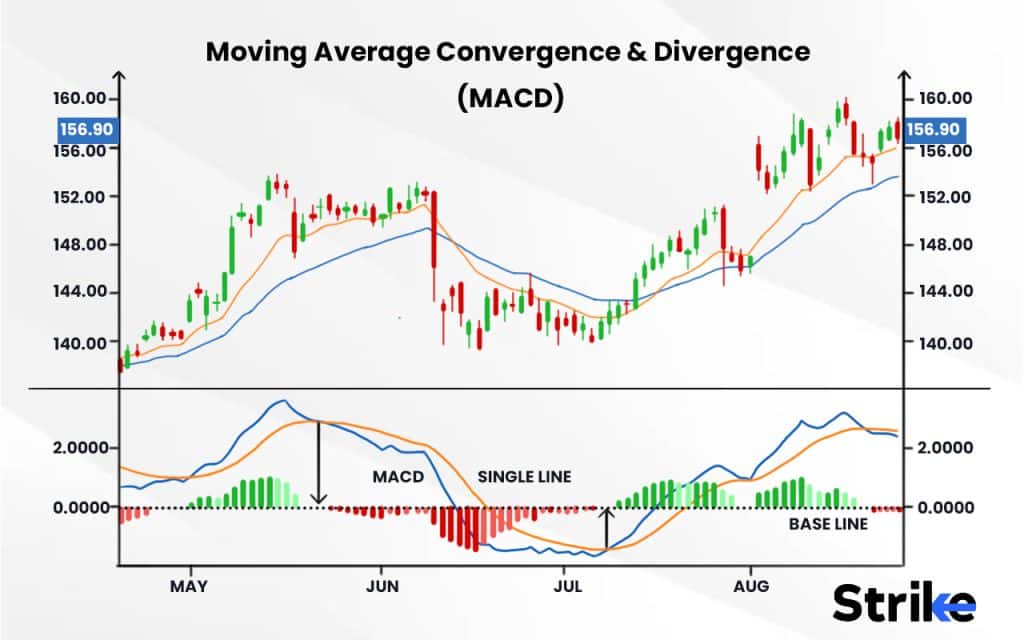
The MACD indicator is the result of subtracting the long-term exponential moving average from the short-term exponential moving average. It was created by Gerald Appeal in the late 1970s. The MACD indicator works with 3 components, namely the MACD line, the signal line and the histogram.
Commodity Channel Index (CCI)
A technical indicator called the Commodity Channel Index (CCI) calculates the difference between the current price and the historical average price. The price is above the historical average when the CCI is greater than zero. In contrast, the price is lower than the historical average when the CCI is below zero.
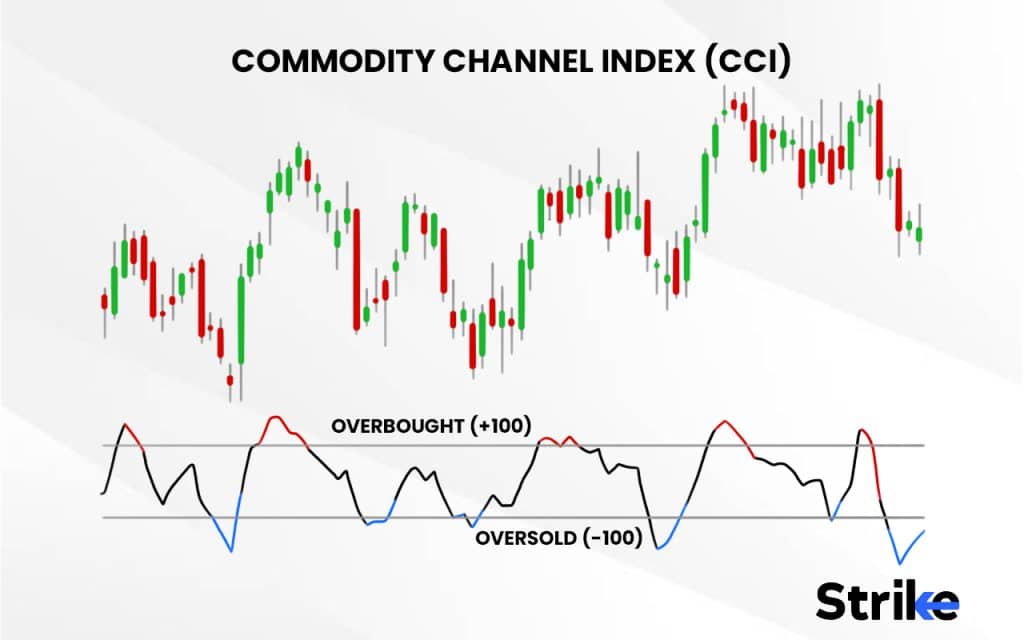
This technical indicator is created by Donald Lambert. It evaluates price trend direction and strength, enabling traders to choose whether to initiate or exit a trade, forgo entering a trade, or increase an existing position.
Relative Strength Indicator (RSI)
Technical analysis uses the relative strength index (RSI), a momentum indicator to assess whether a security’s price is overvalued or undervalued, RSI evaluates the speed and magnitude of recent price fluctuations. The RSI is represented as an oscillator on a scale of 0 to 100.
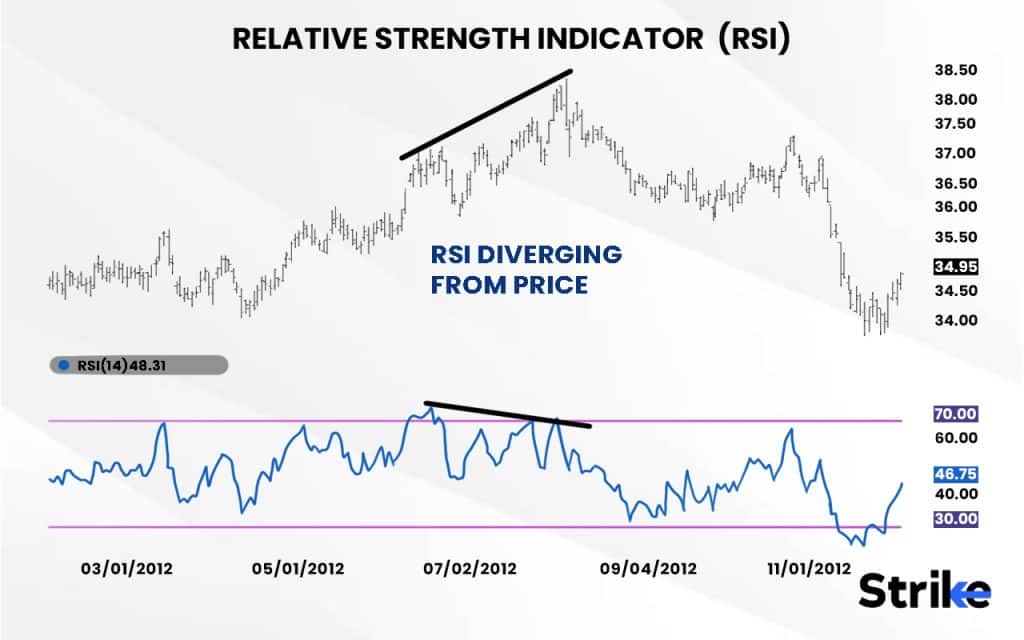
J. Welles Wilder Jr. created the indicator, which he first published in his 1978 book New Concepts in Technical Trading Systems. An overbought scenario is generally indicated by an RSI reading of 70 or higher. An oversold state is indicated by a value of 30 or lower.
Stochastic Indicator
A momentum indicator called a stochastic oscillator compares a security’s closing price to a range of its prices over a specific period of time. The vulnerability of the oscillator to market changes is reduced by changing that time period or by taking a moving average of the outcome. It uses a 0-100 limited range of values to provide overbought and oversold trading signals.
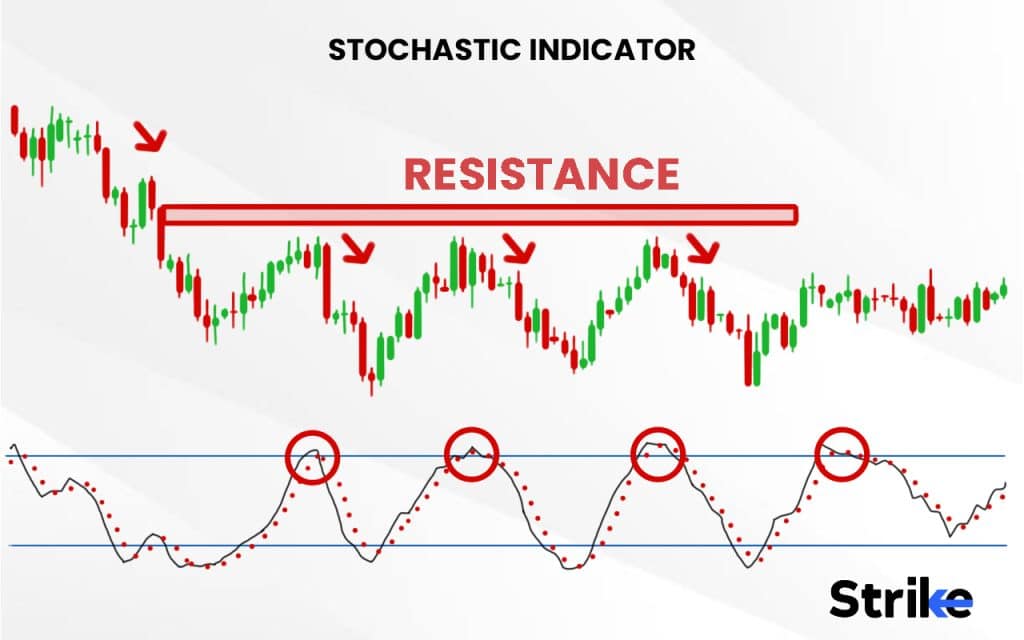
A Stochastic indicator is a two-line indicator that can be used with any chart. The indicator displays a comparison between the current price and the highest and lowest price peaks over a given time period. 14 separate periods typically make up the previous period.
Advance-Decline Issues
Advance-Decline issues is an indicator which comes under the momentum category. It is calculated by subtracting the declining issues from the advancing is
Super Trend
A Super Trend is commonly known as a trend-following indicator. it is similar to moving averages. Super Trend is plotted against price, and its positioning in relation to price makes it easy to identify the present trend. It is constructed using two parameters: period and multiplier. You must open the chart of the specific stock you wish to track in order to use this indicator.
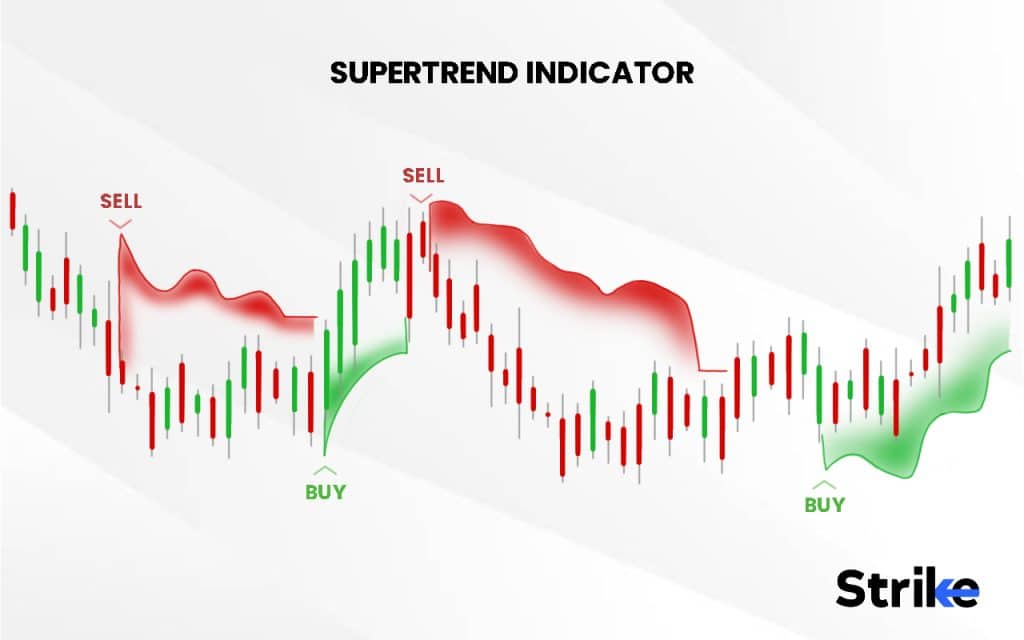
You must also set a time interval of 10 minutes. Insert Supertrend onto the chart after it has been opened, keeping the settings at 10 and 3. You can use your own settings as well. However, you shouldn’t avoid placing your stop loss while using this indicator. You can place your stop loss for a long position exactly at the green indicator line. You can set it at the red indicator line for a short position.
William %R
Williams%R sometimes referred to as the Williams Percent Range, is a form of momentum indicator that tracks overbought and oversold levels and oscillates between 0 and -100. One uses the Williams%R to find entry and exit points in the market. It was created by Larry Williams and evaluates the closing price of a stock against the high-low range during an established period of time, usually 14 days or intervals.
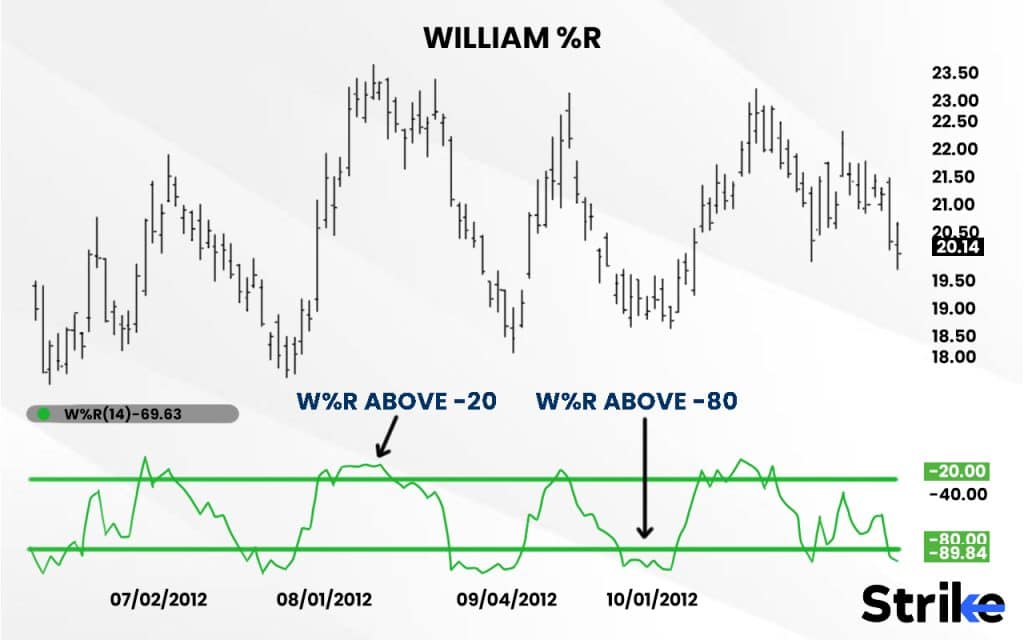
A trader uses the indicator to determine where the price is in relation to the highest high from past 14 periods, or whichever number of lookback periods is selected. The price is overbought or close to the peak of its most recent price range when the indicator is between -20 and zero. The price is oversold or distant from its previous range high when the indicator is between -80 and -100.
Volume
Volume is the total amount of a security or asset that is traded over time, often in a single day. For instance, the amount of shares traded in security between its daily open and close is referred to as stock trading volume. Investors can learn about market activity and liquidity via volume. Higher trade volumes for a given security result in higher liquidity, better order execution, and a more active market for bringing buyers and sellers together.
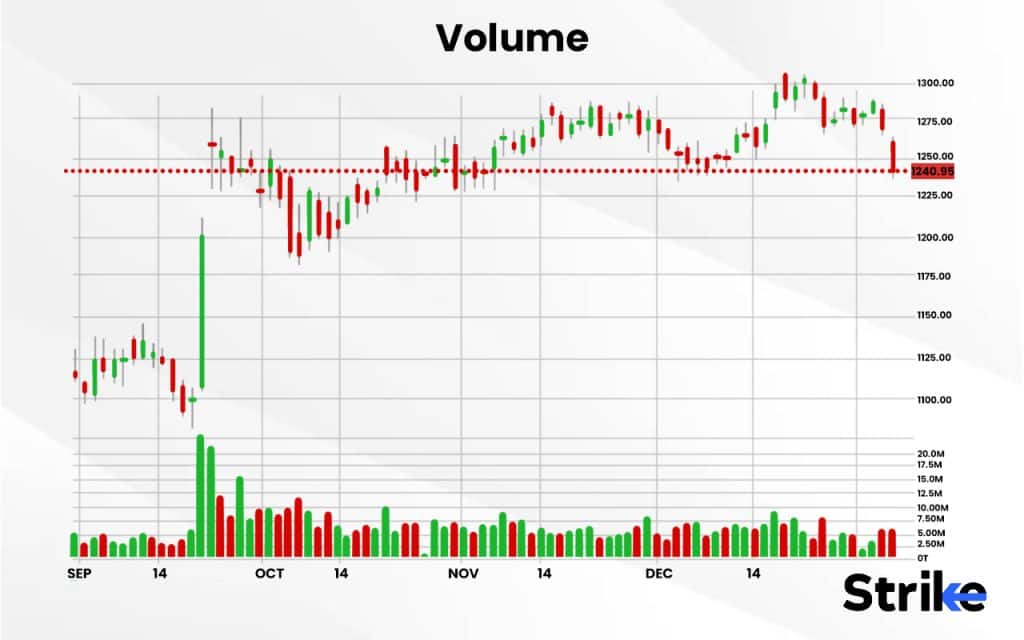
Futures trading volume generally rises when investors are uneasy about the direction of the stock market, which frequently leads to more active trading in options and futures on particular equities. On Mondays and Fridays, as well as during the market’s opening and closing hours, there is generally more activity overall. Prior to a holiday and during lunchtime, it is typically lower.
Price Volume Trend
Price and Volume Trend (PVT) is used to assess the strength of trends and signal reversals. It is a version of the On-Balance-Volume’(OBV). PVT is a horizontal histogram placed above a price chart. The histogram bars extend to the right starting at the left side of the chart. The sum of all volume bars during the times when the closing price was inside the histogram bar’s vertical range determines the length of each bar. PVT is an indicator of upcoming price changes.
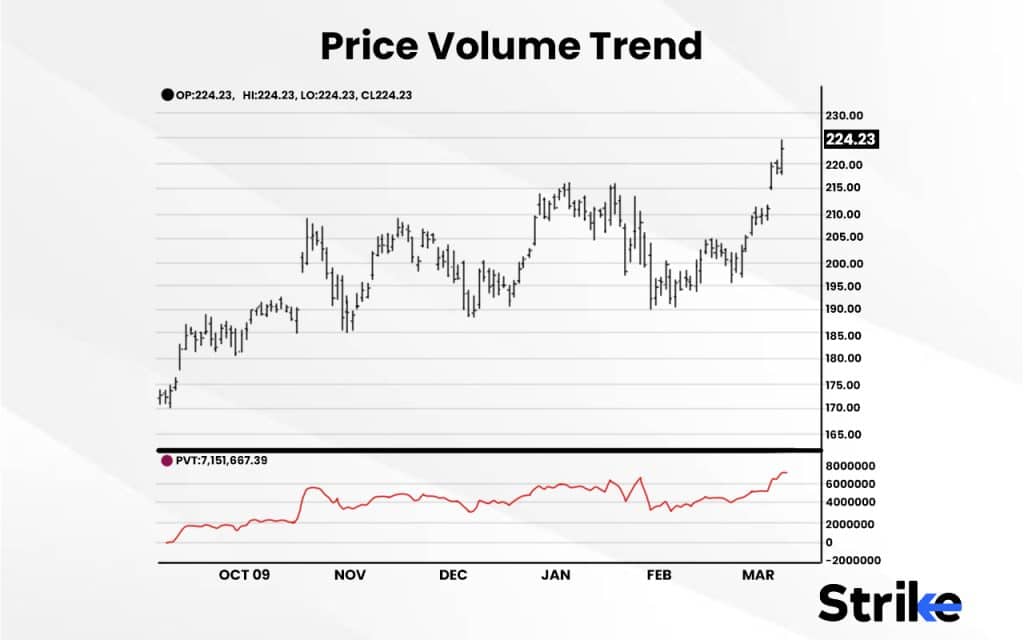
Although the Accumulation/Distribution indicators and OBV are similar to PVT, PVT more accurately depicts the flow of money. PVT only adds a proportional amount of volume to the indicator, but OBV adds the same volume regardless of whether the market increases in price by three times or just a fraction of a point.
Exponential Moving Average (EMA)
An exponential moving average (EMA) is a particular kind of moving average (MA) that gives the most recent data points more weight and relevance. The exponential weighted moving average is another name for the exponential moving average. An exponentially weighted moving average responds more strongly to recent price movements in comparison to a simple moving average (SMA), which gives equal weight to all observations across time.
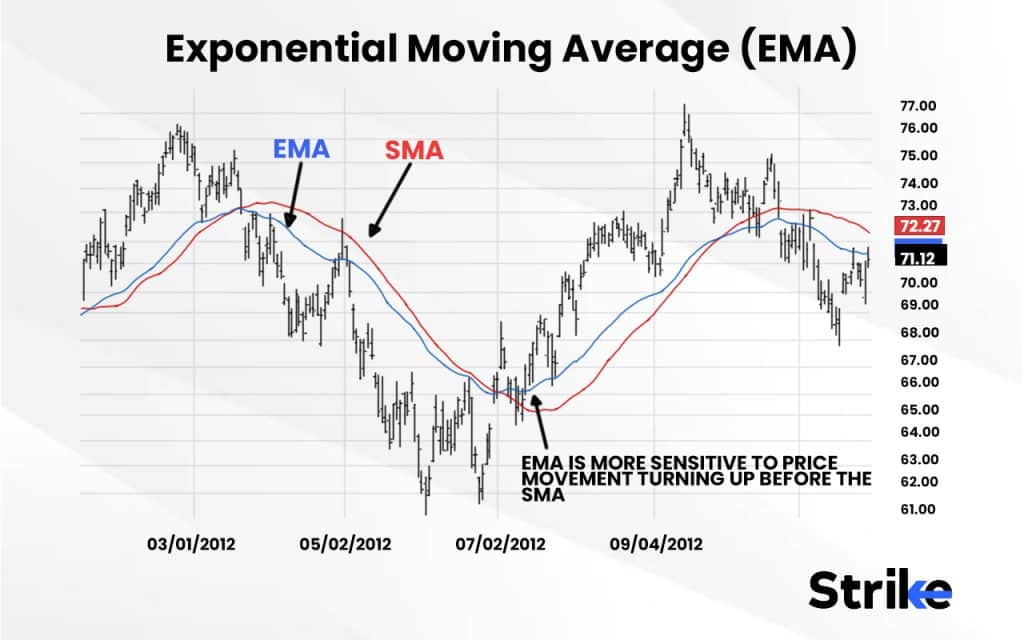
The 12- and 26-day exponential moving averages (EMAs) are the most frequently quoted and studied short-term averages. Indicators like the moving average convergence divergence (MACD) and the percentage price oscillator (PPO) are made using the 12- and 26-day. In general, indications for long-term trends are employed with the 50- and 200-day EMAs. Crossing a stock price’s 200-day moving average is a technical indicator that a reversal has taken place.
Open Interest
The quantity of options or futures contracts held by investors and traders in active positions is known as open interest. Open interest is the entire number of outstanding derivative contracts for an asset, such as options or futures that have not been settled. Open interest keeps track of each open position in that contract, instead of measuring the entire volume traded in a single contract, which also includes netting or closing positions. In order to determine if cash inflows into the contract are rising or falling, open interest can thus give a more precise picture of a contract’s liquidity and interest.

Open interest is one statistic that technical analysts use in conjunction with others to determine the strength of a market trend. Growing open interest is used to confirm a current market trend because it shows that fresh traders are entering the market. The current trend may be weakening as a result of traders closing their positions, as evidenced by declining open interest.
McClellan Oscillator
The McClellan Oscillator, created by Sherman and Marian McClellan, is a breadth indicator derived from Net Advances, which is the difference between advancing issues and declining issues. The oscillator is produced by deducting the 19-day exponential moving average of Net Advances from the 39-day exponential moving average of Net Advances.
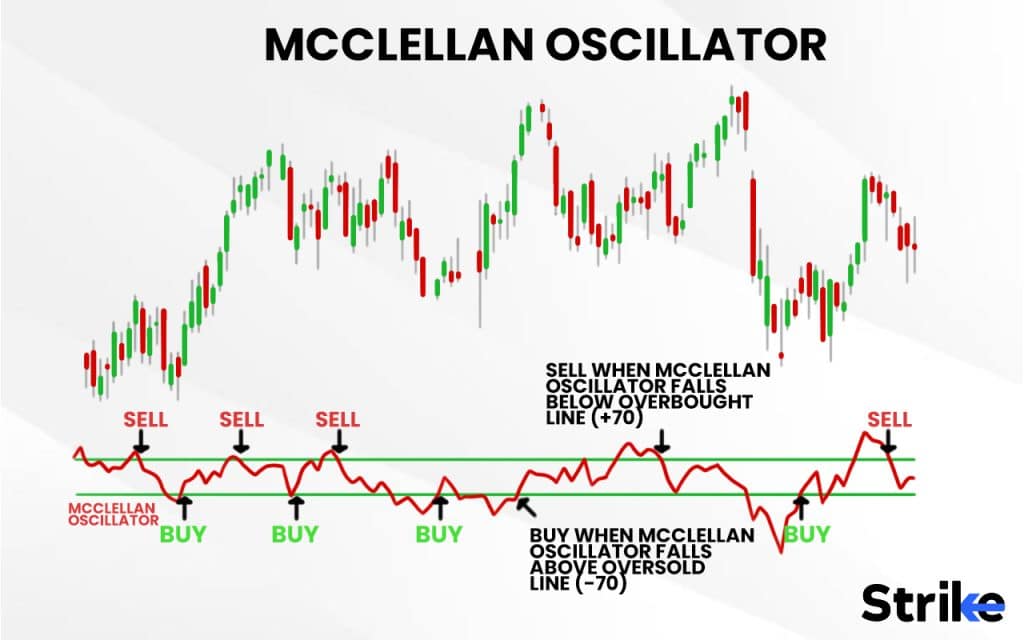
The McClellan Oscillator is a momentum indicator that functions similarly to MACD. Divergences, centerline crossovers, and breadth thrusts can all produce McClellan oscillator signals.
Fibonacci Retracement
Fibonacci retracement is a technical analysis technique used in finance to identify levels of support and resistance. The Fibonacci number sequence, whose ratios indicate price levels at which markets typically retrace a portion of a move before a trend continues in the original direction, inspired the name of the indicator.
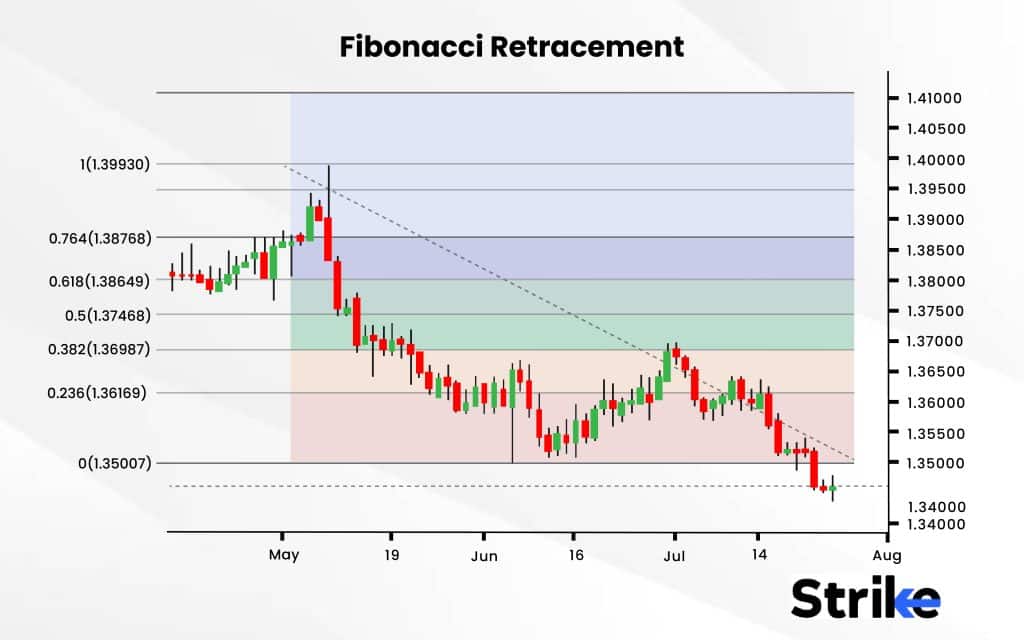
One can calculate a Fibonacci retracement by dividing the vertical distance between two extreme points on a chart by the Fibonacci ratios. 0% is regarded as the beginning of the retracement while 100% is a complete return to the price before the move. Horizontal lines are created on the chart for these price points to indicate levels of support and resistance. The typical ranges are 23.6%, 38.2%, 50%, and 61.8%.
On Balance Volume Indicator
A technical trading momentum indicator called on-balance volume (OBV) makes use of volume flow to forecast changes in stock price. Joseph Granville invented the OBV metric in his 1963 book Granville’s New Key to Stock Market Profits. The foundation of OBV theory is the distinction between institutional investors and less experienced ordinary investors.
Volume rises even while the price is relatively flat as mutual funds and pension funds start to invest in an issue that regular investors are selling. Volume eventually causes the price to rise. Then, bigger investors start to sell, and smaller investors start to buy.
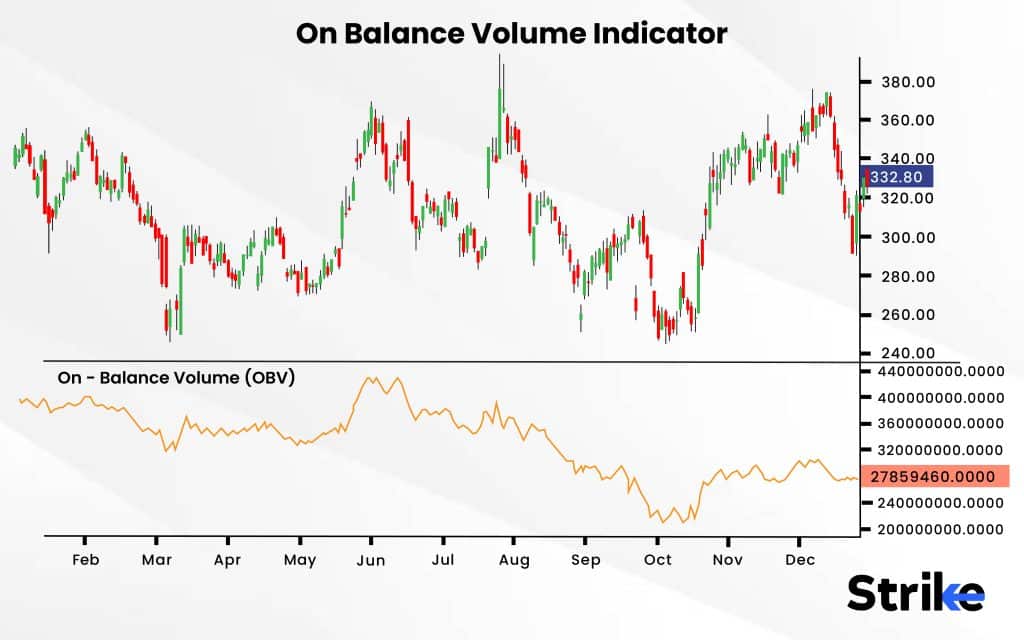
The actual individual quantitative value of OBV is not significant, despite being shown on a price chart. The time interval is determined by a certain starting point while the indicator itself is cumulative, the real number value of OBV depends solely on the start date. Traders and analysts focus on the nature of OBV fluctuations over time; however, analysis is solely based on the slope of the OBV line.
Aroon
Technical indicators like the Aroon indicator can be used to determine the direction and strength of a trend as well as changes in an asset’s price. The indicator essentially counts the intervals between highs and lows over a given period of time. Strong uptrends and downtrends are supposed to frequently reach new highs and lows, respectively. The “Aroon up” line of the indicator, which evaluates the strength of uptrends, and the “Aroon down” line, which evaluates the strength of downtrends, make up the entire system. Tushar Chande created the Aroon indicator in 1995. Crossovers of the two lines indicate the trend changes. For instance, when Aroon Up crosses over Aroon Down, it signals the beginning of a new uptrend.
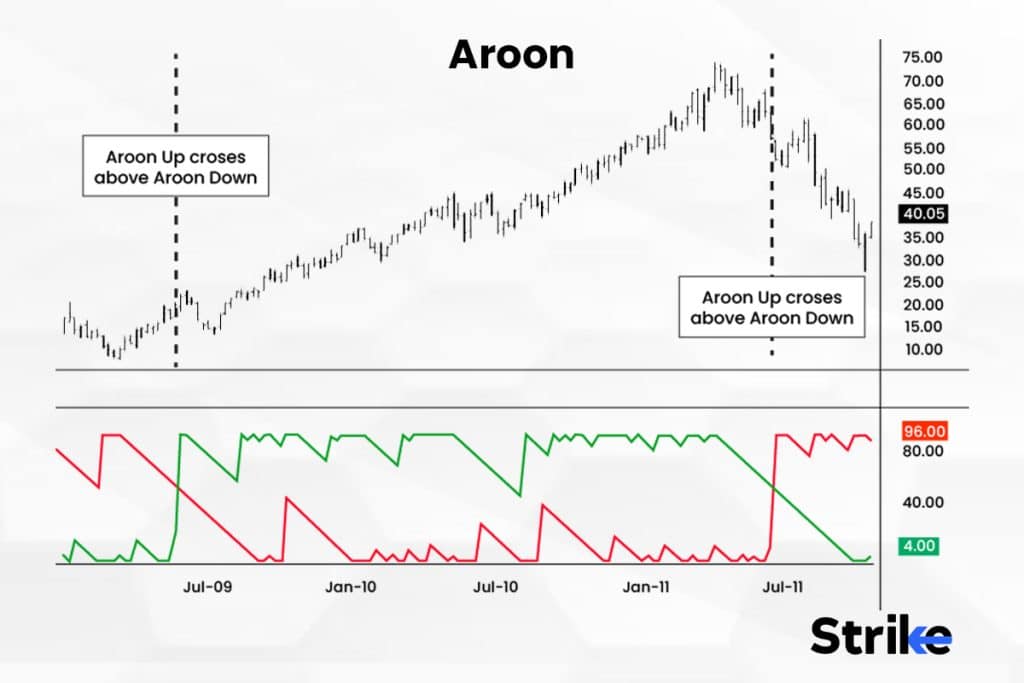
Indicator values range from 0 to 100. A value greater than 50 indicates that a high or low (whichever line is higher than 50) was observed within the previous 12 periods. A reading is less than 50 means a high or low was observed within the 13 periods.
Correlation Coefficient
The correlation coefficient is a statistical indicator of the strength of the linear relationship between two variables. Its values range between -1 and 1. According to a correlation coefficient of -1 values in one series rise as those in the other drop, and vice versa, denoting a complete negative or inverse connection. A value of 1 indicates a direct and flawlessly positive connection. No linear relationship exists when the correlation coefficient is 0. Correlation coefficients are used to measure the degree of relationship between two variables, factors, or data sets. The most commonly used correlation coefficient, called the Pearson correlation coefficient, measures the strength and direction of a linear relationship between two variables.
Money Flow Index
The Money Flow Index (MFI) is a momentum indicator measured by the money flowing into and out of an investment over a predetermined time period. It is similar to the Relative Strength Index (RSI), but it also takes volume into account, whereas the RSI just takes price into account. A technical oscillator called the Money Flow Index (MFI) analyses price and volume information to spot overbought or oversold indications in an asset.
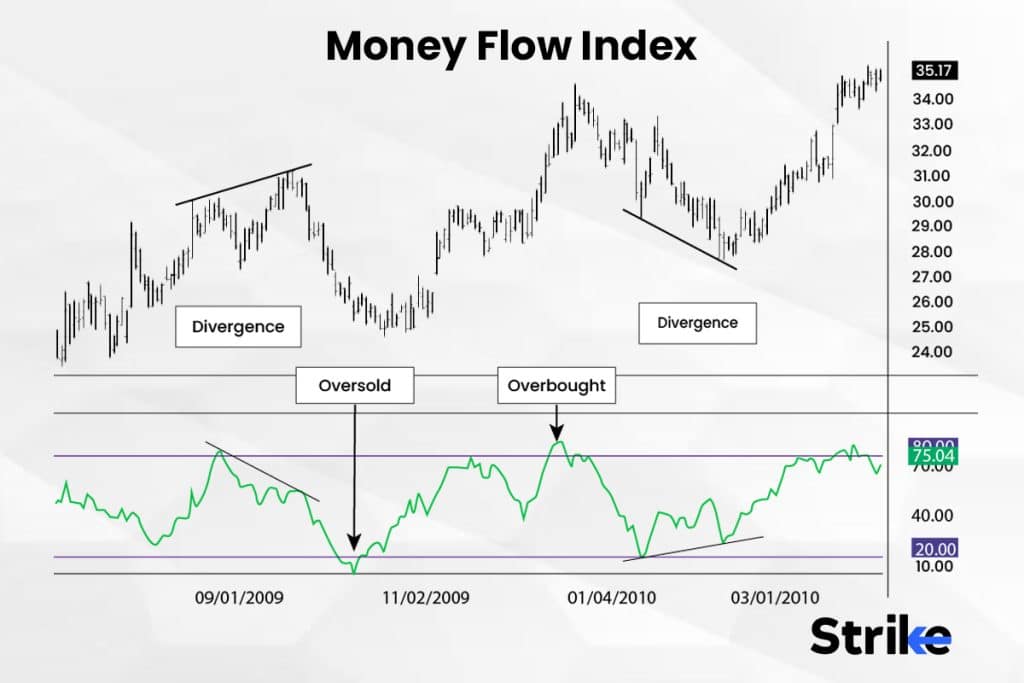
It can also be used to identify divergences that signal a shift in price trends. Oscillator movement ranges from 0 to 100. Although levels of 90 and 10 are also used as thresholds, an MFI reading above 80 is regarded as overbought, and an MFI reading below 20 is regarded as oversold.
Bollinger Bands
John Bollinger created a particular kind of price envelope he called Bollinger Bands. Upper and lower price range levels are indicated by price envelopes. Bollinger Bands are envelopes that are drawn above and below a price’s simple moving average at a certain standard deviation level. The bands’ width adjusts to changes in the underlying price’s volatility because it is based on standard deviation.
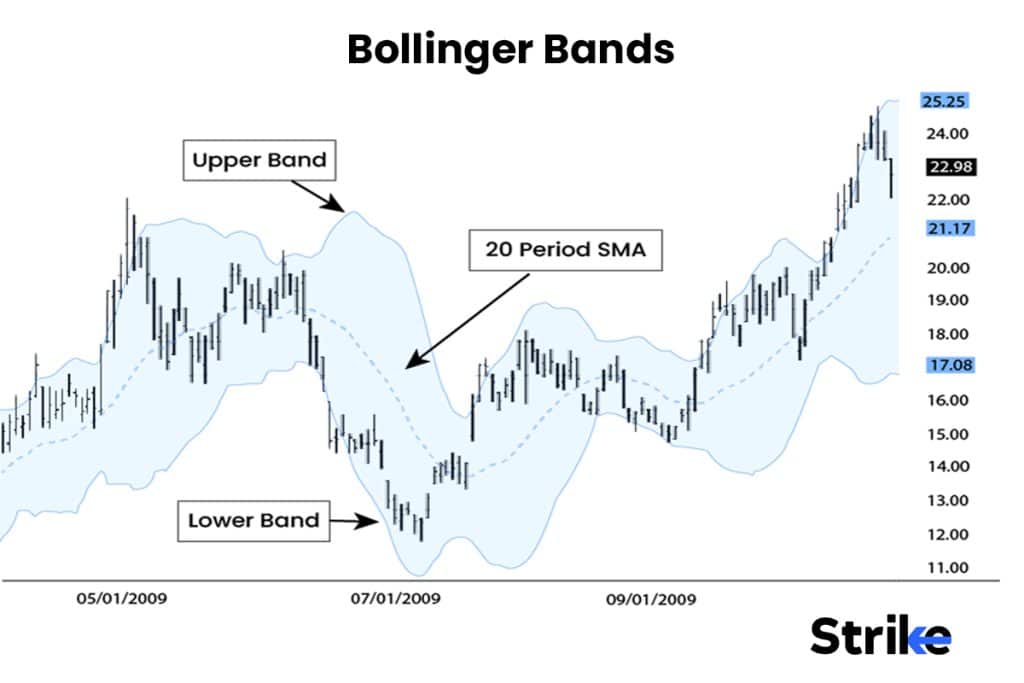
Period and Standard Deviations are the two parameters used by Bollinger Bands. The default settings for the period and standard deviation are 20 and 2, respectively, although you can alter the pairings. Bollinger bands assist in identifying relative price highs and lows. Both the upper and lower bands are used in pairs, along with a moving average.
Donchain
Donchian Channels are a three-line indicator made up of upper and lower bands around a midway or median band that is produced using moving average calculations. The upper band denotes the security’s greatest price over N periods, while the lower band denotes the security’s lowest price over N periods. The Donchian Channel is the region that lies between the upper and lower bands.
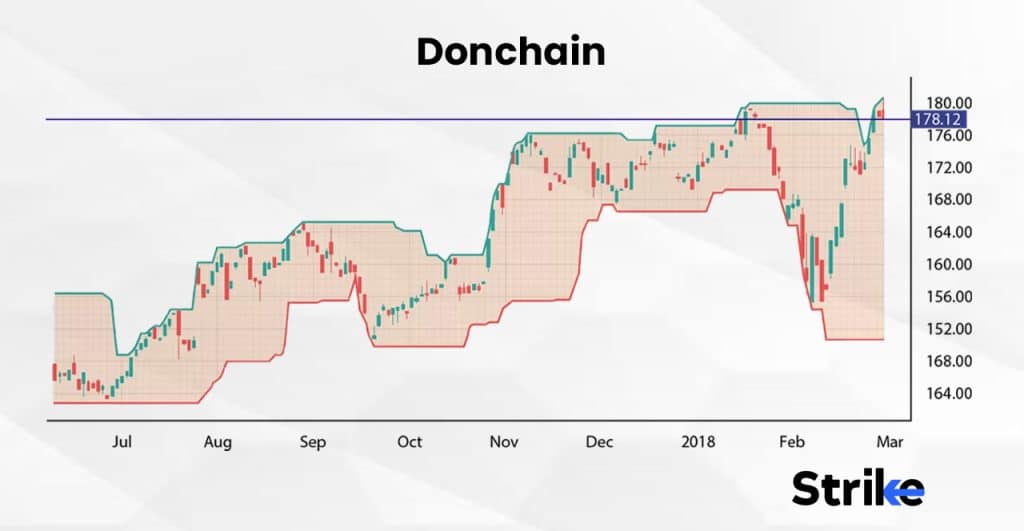
The indicator was created by professional futures trader Richard Donchian in the middle of the 20th century to aid with trend detection. Donchian Channels reveal comparisons between trading ranges and the current price over defined time periods. Similar to Bollinger Bands, three values create a visual representation of price over time that shows the degree of bullishness and bearishness for the selected time period. The top line indicates the degree of bullish energy by emphasizing the highest price realized throughout the relevant time frame as a result of the bull-bear struggle.
The center line shows the mean or median price for the time period, emphasizing the compromise achieved for the period through the bull-bear conflict. The bottom line shows the extent of the bearish energy indicating the lowest price for the time frame across the bull-bear battle.
Volume-Weighted Average Price
The ratio of the value of a securities or other financial instrument traded to the total volume of transactions made during a trading session is known as the volume-weighted average price (VWAP) in the world of finance. It serves as an indicator of the time period’s average trade price.
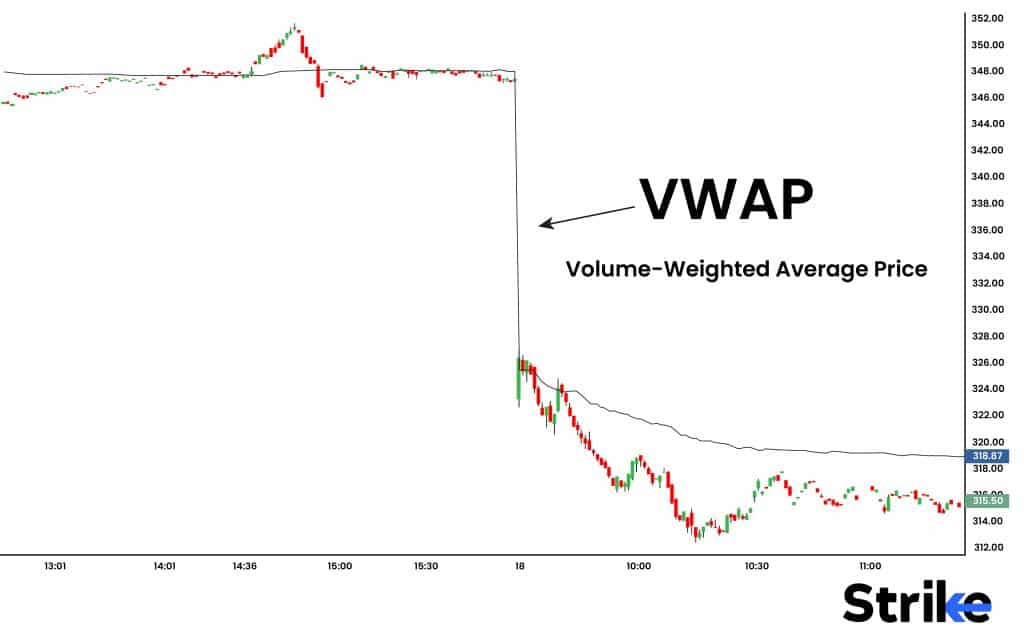
The indicator can be calculated for any number of days, however, it is typically computed for one day. Investors that want to execute trades as passively as possible frequently utilise VWAP as a benchmark in their trading. This includes a lot of mutual funds and pension funds. The trader can make sure that the order is executed in accordance with market volume by setting a VWAP trading target.
Traders employ VWAP in many ways. VWAP is used by traders to confirm trends and to create trading rules. They might view equities as undervalued or overvalued depending on whether their prices are below or above VWAP. Traders buy the stock if prices below VWAP rise above it. They might sell their positions or start short positions if prices above VWAP move below it. VWAP enables institutional buyers, including mutual funds, to enter or exit the stock market with the least amount of market impact possible. Institutions will therefore attempt to buy below the VWAP or sell above it whenever they can. In doing so, they cause the price to return to the average rather than away from it.
New Highs-New Lows
“New lows” refers to the number of equities that hit new 52-week lows. The number of equities setting new 52-week highs is referred to as “new highs”. This indicator gives a quick assessment of the market’s intrinsic strength or weakness. There are more new highs, which benefits the bulls. There are more new lows, which helps the bears when the indicator is negative. Chartists can use a moving average or daily fluctuations to build oscillators that drift over and below the zero line.
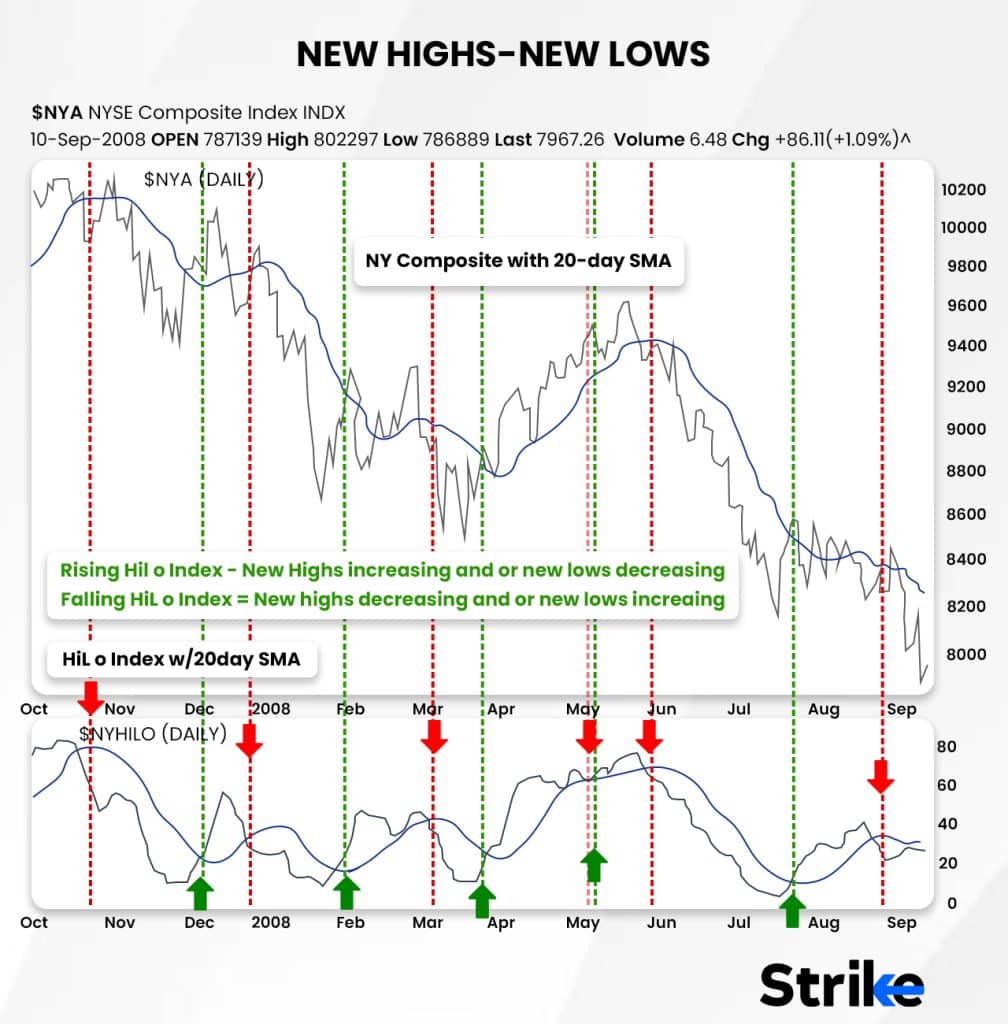
At significant turning points, new highs and new lows frequently trail the underlying index. In other words, the market will turn before there is a noticeable change in new highs and new lows by one to three months. A new high or low is created over a period of at least 52 weeks. A stock must consequently make a significant move in order to reach a 52-week milestone.
There are many new highs to be reached after an extended advance, just as there are many new lows to be reached after a protracted decline. New highs stop occurring when a stock index corrects after an extended advance. Some new lows appear during a correction, a prolonged decline is necessary to produce a significant rise in new lows.
McClellan Ratio-Adjusted Oscillator
The McClellan ratio-adjusted Oscillator regulates net Advances by dividing them by advances plus declines. The decimal point is then added to this ratio by multiplying it by 1000.
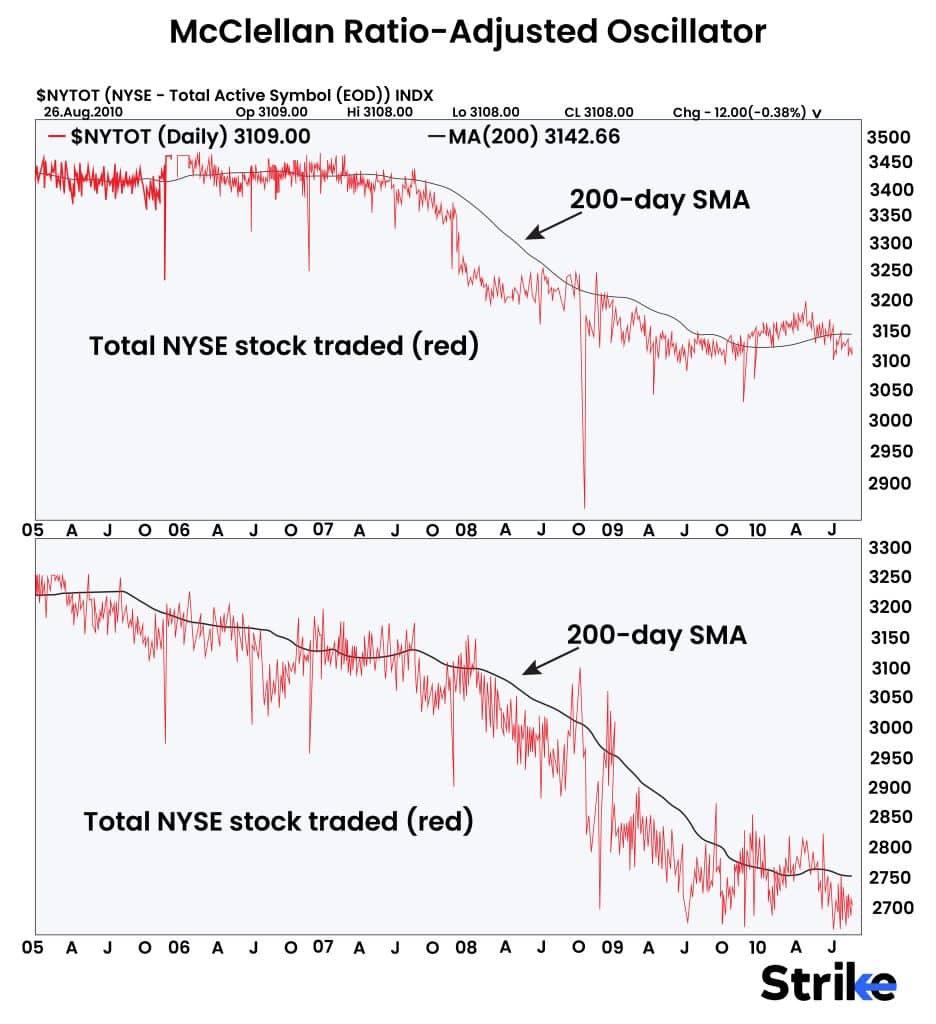
Given that the total number of traded stocks fluctuates over time, this ratio illustrates Net Advances in relation to the total number of traded stocks.
Average Directional Index
The average directional index (ADX) is a market indicator applied by some traders to evaluate the strength of a trend. Two auxiliary indicators, the negative directional indicator (-DI) and the positive directional indicator (+DI), indicate whether the trend is up or down. Therefore, the ADX often includes three different lines. These are employed to determine if a trade should be entered into long or short or even at all.
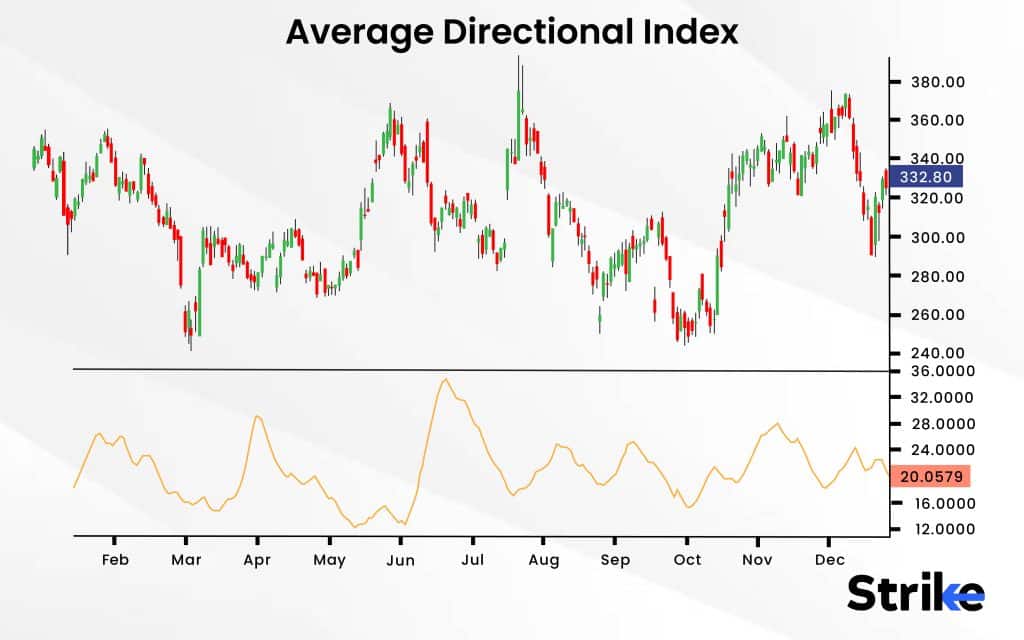
The ADX, which Welles Wilder created for commodity daily charts, is currently utilized by technical traders in a number of markets to determine the strength of a trend. According to Wilder, the trend is strong when the ADX is above 25, whereas the trend is weak or the price is trendless when the ADX is below 20.
Ticks Index
The tick index is a common indicator that day traders use to see how the market is feeling all at once. The index subtracts equities that experience a decline from stocks that experience an increase. Trading choices that are based on market movement can be made quickly by traders by looking at the ratio of “up” stocks to “down” stocks. A tick index is a momentary indicator that often only has a few minutes of value.
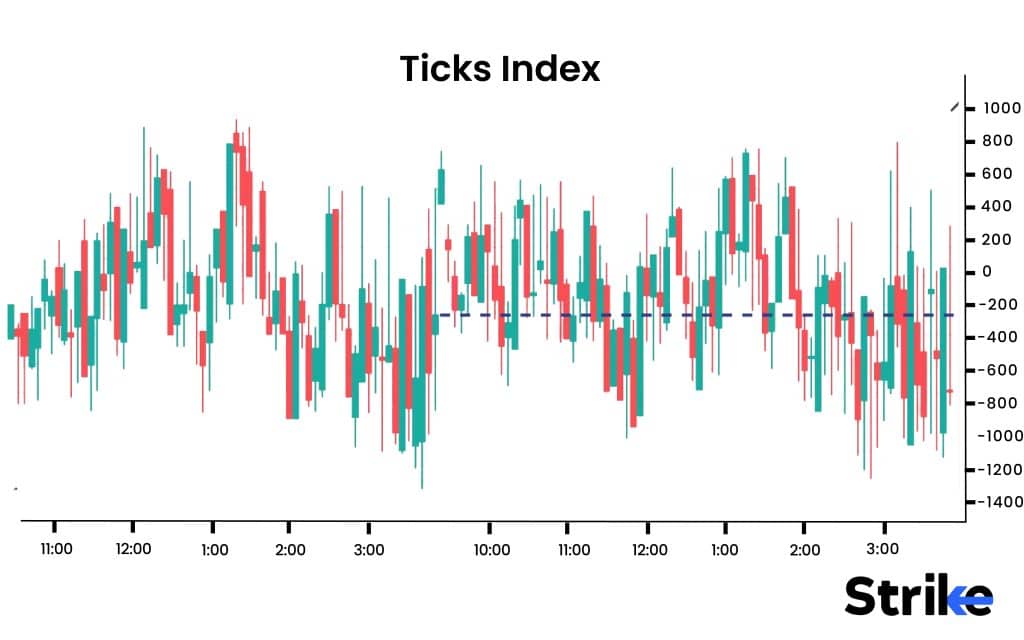
A positive tick index is a solid sign of general market optimism for traders trying to enter into bullish sentiment because it shows that more equities are trading higher than down. The tick index is a very speculative indicator of market sentiment at a certain moment in time, and it is regarded as unreliable for traders who utilize longer-term methods.
Plurality Index
The plurality index is a market breadth indicator based on the number of advances and declines. Paul L. Dysart was the one who created the plurality index. Paul was a trading innovator who used several volume-based trading research. The absolute difference between gains and declines over a period of 25 days is added to create the Plurality Index, which is always positive. High plurality index numbers indicate an impending bottom and lower High numbers in plurality index indicate an impending top.
How to Understand Which Market Indicator to Use?
Each trader is responsible for deciding which technical indicators to use and how to use them effectively. The majority of widely used indicators, including moving averages and oscillators, enable some degree of customization by merely changing input values or the user-defined variables that alter the indicator’s behavior. Many of the advanced trading platforms available today let traders conduct optimization analyses to identify the input that yields the best performance. The platform will run calculations to identify the input that yields the most advantageous outcomes based on the range that traders enter for a given input. So, it entirely depends on the trader to choose the market indicator according to his requirement.
What is the most commonly used Market Indicator Type for beginners?
The most commonly used Market Indicator Type for beginners is the moving average. A moving average is a technical analysis tool that creates a continuously updated average price to assist smooth out price data. It is calculated by averaging the prices of securities over a given time frame and is frequently represented as a line on a chart. For those who are just getting started with technical analysis, moving averages can be a helpful tool because they are reasonably straightforward and simple-to-understand market indicators.
Do Different Market States require to use of Different Market Indicators?
Yes, different market states often require the use of different market indicators. This is due to the fact that various indicators are made to capture multiple aspects of market behavior, and certain market circumstances may require the usage of several indicators in order to correctly analyze and comprehend the market. For instance, during a strong uptrend, momentum indicators like the Moving Average Convergence Divergence (MACD) or Relative Strength Index (RSI) may be helpful for spotting overbought conditions and potential trend reversals. However, during a sideways market, indicators like pivot points or Bollinger Bands that are meant to pinpoint support and resistance levels may be more helpful.
How to Use Market Indicators in Stock Market?
There are 5 steps that a trader must keep in mind while using a market indicator in the stock market; choose the indicator that works best for you, identify the market trend, look for signals, use multiple indicators, and manage risks.
- Choose the indicator that works best for you: There are numerous available market indicators, and each one is made to measure certain aspects of market behavior. Moving averages, the relative strength index (RSI), stochastic oscillators, MACD, Bollinger Bands, and Fibonacci retracements are a few common indicators. Pick the ones that fit your trading requirements, strategy, and tolerance for risk.
- Identify the market trend: Use indicators like moving averages or trendlines to figure out whether the market is experiencing an uptrend, downtrend, or range-bound behavior.
- Look for signals: Keep an eye out for signs that might indicate a good time to buy or sell after identifying the market trend.
- Use multiple indicators: It’s crucial to employ multiple indicators to support your analysis because market indicators are not always accurate. In order to improve the possibility of a profitable trade, look for signals that are supported by a number of different indicators.
- Manage risks: Use stop-loss orders and take into account the entire risk/reward ratio of each transaction to reduce potential losses.
The success of stock market trading is not assured by the use of market indicators. It’s critical to combine technical analysis with fundamental analysis and keep up with market news and happenings to reduce risks.
How to Use Market Indicators in Indian Stock Market?
For many, it can be difficult to interpret the Indian stock market chart and choose solid stocks. In a highly volatile environment, technical indicators for the Indian stock market aid traders in understanding market patterns. Intraday traders primarily use market indicators while trading stocks since technical analysis and technical charts are intended to analyze short-term price movements. In Indian stock market statistics, technical stock market indicators are another tool used by long-term investors to determine entry and exit positions.



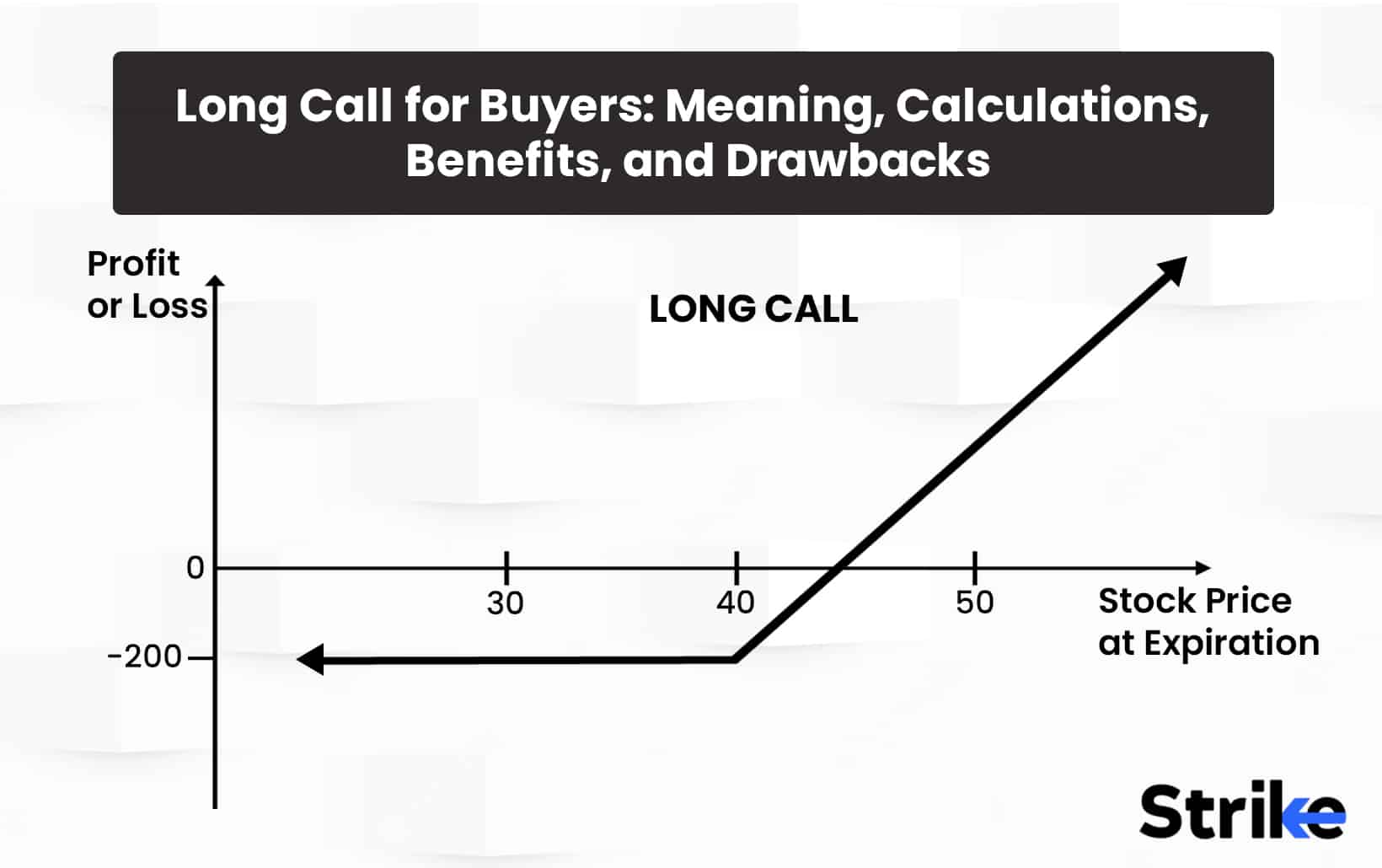
![85 Common Stock Market Terminologies for Dummies [Updated List for 2025] 60 85 Common Stock Market Terminologies for Dummies [Updated List for 2025]](https://www.strike.money/wp-content/uploads/2025/04/Popular-Stock-Market-Terms-for-Beginners-Banner.png)











No Comments Yet.